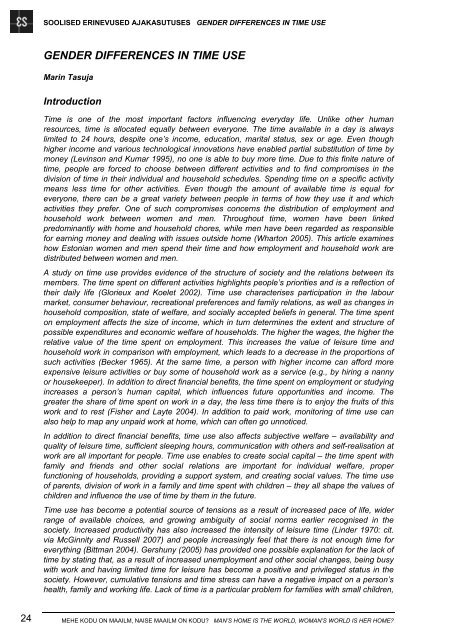MEHE KODU ON MAAILM, NAISE MAAILM ON KODU? - Tartu Ãlikool
MEHE KODU ON MAAILM, NAISE MAAILM ON KODU? - Tartu Ãlikool
MEHE KODU ON MAAILM, NAISE MAAILM ON KODU? - Tartu Ãlikool
Create successful ePaper yourself
Turn your PDF publications into a flip-book with our unique Google optimized e-Paper software.
SOOLISED ERINEVUSED AJAKASUTUSES GENDER DIFFERENCES IN TIME USE<br />
GENDER DIFFERENCES IN TIME USE<br />
Marin Tasuja<br />
Introduction<br />
Time is one of the most important factors influencing everyday life. Unlike other human<br />
resources, time is allocated equally between everyone. The time available in a day is always<br />
limited to 24 hours, despite one’s income, education, marital status, sex or age. Even though<br />
higher income and various technological innovations have enabled partial substitution of time by<br />
money (Levinson and Kumar 1995), no one is able to buy more time. Due to this finite nature of<br />
time, people are forced to choose between different activities and to find compromises in the<br />
division of time in their individual and household schedules. Spending time on a specific activity<br />
means less time for other activities. Even though the amount of available time is equal for<br />
everyone, there can be a great variety between people in terms of how they use it and which<br />
activities they prefer. One of such compromises concerns the distribution of employment and<br />
household work between women and men. Throughout time, women have been linked<br />
predominantly with home and household chores, while men have been regarded as responsible<br />
for earning money and dealing with issues outside home (Wharton 2005). This article examines<br />
how Estonian women and men spend their time and how employment and household work are<br />
distributed between women and men.<br />
A study on time use provides evidence of the structure of society and the relations between its<br />
members. The time spent on different activities highlights people’s priorities and is a reflection of<br />
their daily life (Glorieux and Koelet 2002). Time use characterises participation in the labour<br />
market, consumer behaviour, recreational preferences and family relations, as well as changes in<br />
household composition, state of welfare, and socially accepted beliefs in general. The time spent<br />
on employment affects the size of income, which in turn determines the extent and structure of<br />
possible expenditures and economic welfare of households. The higher the wages, the higher the<br />
relative value of the time spent on employment. This increases the value of leisure time and<br />
household work in comparison with employment, which leads to a decrease in the proportions of<br />
such activities (Becker 1965). At the same time, a person with higher income can afford more<br />
expensive leisure activities or buy some of household work as a service (e.g., by hiring a nanny<br />
or housekeeper). In addition to direct financial benefits, the time spent on employment or studying<br />
increases a person’s human capital, which influences future opportunities and income. The<br />
greater the share of time spent on work in a day, the less time there is to enjoy the fruits of this<br />
work and to rest (Fisher and Layte 2004). In addition to paid work, monitoring of time use can<br />
also help to map any unpaid work at home, which can often go unnoticed.<br />
In addition to direct financial benefits, time use also affects subjective welfare – availability and<br />
quality of leisure time, sufficient sleeping hours, communication with others and self-realisation at<br />
work are all important for people. Time use enables to create social capital – the time spent with<br />
family and friends and other social relations are important for individual welfare, proper<br />
functioning of households, providing a support system, and creating social values. The time use<br />
of parents, division of work in a family and time spent with children – they all shape the values of<br />
children and influence the use of time by them in the future.<br />
Time use has become a potential source of tensions as a result of increased pace of life, wider<br />
range of available choices, and growing ambiguity of social norms earlier recognised in the<br />
society. Increased productivity has also increased the intensity of leisure time (Linder 1970: cit.<br />
via McGinnity and Russell 2007) and people increasingly feel that there is not enough time for<br />
everything (Bittman 2004). Gershuny (2005) has provided one possible explanation for the lack of<br />
time by stating that, as a result of increased unemployment and other social changes, being busy<br />
with work and having limited time for leisure has become a positive and privileged status in the<br />
society. However, cumulative tensions and time stress can have a negative impact on a person’s<br />
health, family and working life. Lack of time is a particular problem for families with small children,<br />
24<br />
<strong>MEHE</strong> <strong>KODU</strong> <strong>ON</strong> <strong>MAAILM</strong>, <strong>NAISE</strong> <strong>MAAILM</strong> <strong>ON</strong> <strong>KODU</strong>? MAN’S HOME IS THE WORLD, WOMAN’S WORLD IS HER HOME?

















